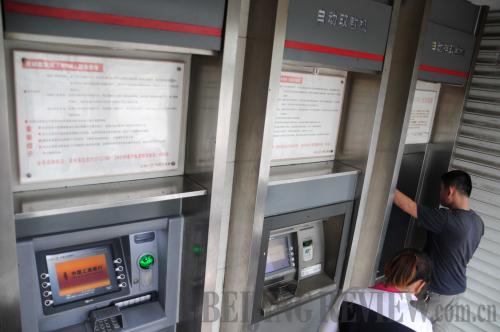|
 |
|
MALFUNCTION: A customer at the Industrial and Commercial Bank of China uses an ATM in Binzhou, Shandong Province. The bank's cash machines were allegedly down on June 22 for an hour following news of the credit crunch (CFP) |
Face-off
To clamp down on simmering risks, the central bank issued a regulation on June 17, warning commercial banks to stop excess credit and daring capital spending.
Commercial banks in China usually see the central bank as a "caring mother." Whenever there is a liquidity crunch, the "mom" would lower the reserve requirement ratio to inject liquidity.
But to the surprise of all banks, the central bank didn't come to their rescue this time, which underscores the new leadership's goal to reform the country's economy into a more sustainable and market-based one, as rampant credit growth is likely to distort economic reality.
Wang Yong, an analyst from the CITIC Securities, said that the central bank wants to punish commercial banks this time and force banks to solve their own problems. "This can give them more discipline and urge them to issue rational loans in the future. Although this may cause short-term market panic, it's a price worth paying," said Wang.
According to the accounting firm PricewaterhouseCoopers, bad loans and overdue loans in China's 10 listed banks reached 376.2 billion ($61.2 billion) and 486.5 billion yuan ($79.2 billion), respectively, at the end of 2012.
On June 25, to ease market fear, the central bank issued a statement on its website, reaffirming its drive to get banks to control their lending. But the central bank also said that it would provide cash to institutions that support the real economy.
The PBC said it will keep the money markets stable with a combination of tools, including open market operations, re-lending, rediscounting, short-term liquidity operations and standard lending facilities.
"For financial institutions that extend loans to the real economy and develop with a prudent lending pace, the central bank will provide liquidity support if they temporarily lack capital."
The Shanghai interbank overnight rate declined to 5.736 percent on June 25.
Cao Xuefeng, head of research at the Sichuan-based Huaxi Securities, said the tight lending is a new policy decision by Premier Li Keqiang.
Cao was echoed by Zhang Zhiwei, a China economist for Nomura Securities.
"The liquidity squeeze is the first real economic test for China's new leaders, to prove their willingness to overcome tough economic issues not with words but by their actions," said Zhang in a research note.
"If the new leaders maintain their current approach, we believe it will add downside risk to growth in 2013, but in our opinion this would help reduce systemic financial risks and support long-term sustainable growth."
Eyeing reform
During the past three decades of China's reform and opening-up, Chinese banks expanded recklessly by lending to a number of sectors. According to the China Banking Regulatory Commission, the total assets of Chinese banks reached 130 trillion yuan ($22.78 trillion) at the end of 2012.
What China lacks is not money supply but a sound financial system. That's why the central bank refused to inject liquidity to the markets as a way to force banks to transform their growth patterns.
How can this be done? The central bank says that banks should invigorate existing loans by retreating from high-risk loans and investing instead into more productive areas of the economy. Also, they should increase the quality of their assets and expand the scale of their financial services. The financial sector should serve the real economy, it said.
"On the surface, the liquidity shortage is the problem of banks. But the reason behind it is a slow financial reform and insufficient supervision," said Zhang Chenghui, Director of the Research Institute of Finance under the Development Research Center of the State Council.
Qu Hongbin, an economist from HSBC, said that the recent credit crunch shows the firm determination of the Chinese Government to reform the banking sector.
"If this happened several years ago, the central banks would have immediately injected liquidity to keep growth stable. But now, with lackluster economic growth and a liquidity crunch among the banks, the central bank still refuses to help commercial banks as it once did. This shows that the current government has a much higher tolerance for a slowdown in economic growth," said Qu.
"The government is more willing to roll out reforms, instead of simply stoking up the economy."
Email us at: zhouxiaoyan@bjreview.com | 